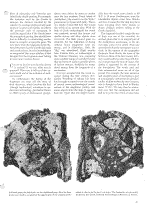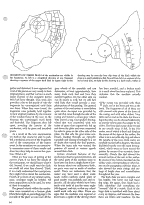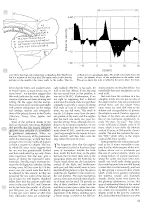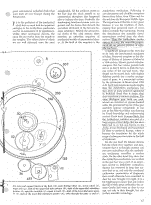|

by Derek J. de Solla Price
Scientific American
June 1959 p.60-7
from
RupertRussell Website
|
In 1901
divers working off the isle of Antikythera found the
remains of a clocklike mechanism that was 2,000 years
old. The mechanism now appears to have been a device for
calculating the motions of stars and planets.
|
Among the treasures of the Greek National Archaeological Museum
in Athens are the remains of the most complex scientific object that
has been preserved from antiquity. Corroded and crumbling from 2,000
years under the sea, its dials, gear wheels and inscribed plates
present the historian with a tantalizing problem.
Because of them we may have to revise
many of our estimates of Greek science. By studying them we may find
vital clues to the true origins of that high scientific technology
which hitherto has seemed peculiar to our modern civilization,
setting it apart from all cultures of the past.
From the evidence of the fragments one can get a good idea of the
appearance of the original object. Consisting of a box with dials on
the outside and a very complex assembly of gear wheels mounted
within, it must have resembled a well- made 18ih-century clock.
Doors hinged to the box served to protect the dials, and on all
available surfaces of box, doors and dials there were long Greek
inscriptions describing the operation and construction of the
instrument.
At least 20 gear wheels of the mechanism
have been preserved, including a very sophisticated assembly of
gears that were mounted eccentrically on a turntable and probably
functioned as a sort of epicyclic or differential, gear-system.
Nothing like this instrument is preserved elsewhere. Nothing
comparable to it is known. from any ancient scientific text or
literary allusion. On the contrary, from all that we know of science
and technology in the Hellenistic Age we should have felt that such
a device could not exist. Some historians have suggested that the
Greeks were not interested in experiment because of a
contempt-perhaps induced by the existence of the institution of
slavery-for manual labor. On the other hand it has long been
recognized that in abstract mathematics and in mathematical
astronomy they were no beginners but rather "fellows of another
college" who reached great heights of sophistication.
Many of the Greek scientific devices known to us from written
descriptions show much mathematical ingenuity, but in all cases the
purely mechanical part of the design seems relatively crude. Gearing
was clearly known to the Greeks, but it was used only in relatively
simple applications. They employed pairs of gears to change angular
speed or mechanical ad- vantage, or to apply power through a right
angle, as in the water-driven mill.
Even the most complex mechanical devices described by the ancient
writers Hero of Alexandria and Vitruvius contained only simple
gearing. For example, the taximeter used by the Greeks to measure
the distance travelled by the wheels of a carriage employed only
pairs of gears (or gears and worms) to achieve the necessary ratio
of movement. It could be argued that if the Greeks knew the
principle of gearing, they should have had no difficulty in
constructing mechanisms as complex as epicyclic gears. We now know
from the fragments in the National Museum that the Greeks did make
such mechanisms, but the knowledge is so unexpected that some
scholars at first thought that the fragments must belong to some
more modern device.
Can we in fact be sure that the device is ancient? If we can, what
was its purpose? What can it tell us of the ancient world and of the
evolution of modern science? To authenticate the dating of the
fragments We must. tell the story of their discovery, which involves
the first (though inadvertent) adventure in underwater archaeology.
Just before Easter in 1900 a party of Dodecanese sponge-divers were
driven by storm to anchor near the tiny southern Greek island of Antikythera (the accent is on the "kyth," pronounced to rhyme with
pith).
There, at a depth of some 200 feet, they found the wreck of an
ancient ship. With the help of Greek archaeologists the wreck was
explored; several fine bronze and marble statues and other objects
were recovered. The finds created great excitement, but the
difficulties of diving without heavy equipment were immense, and in
September, 1901, the "dig' was abandoned. Eight months later
Valerios StaÎs, an archaeologist at the National Museum, was
examining some calcified lumps of corroded bronze that had been set
aside as possible pieces of broken statuary. Suddenly he recognized
among them the fragments of a mechanism.
It is now accepted that the wreck occurred during the first century
B.C. Gladys Weinberg of Athens has been kind enough to report to me
the results of several recent archaeological examinations of the
amphorae, pottery and minor objects from the ship. It appears from
her report that one might reason-ably date the wreck more closely as
65 B.C. ±15 years. Furthermore, since the identifiable objects come
from Rhodes and Cos, it seems that the ship may have. been voyaging
from these islands to Rome, perhaps without calling at the Greek
mainland.
The fragment that first caught the eye of StaÎs was one of the
corroded, inscribed plates that is an integral part of the Antikythera mechanism, as the device later came to be called. StaÎs
saw immediately that the inscription was ancient. In the opinion of
the epigrapher Benjamin Dean Meritt, the forms of the letters are
those of the 'first century B.C.; they could hardly be older than
100 B.C. nor younger than the time of Christ. The dating is
supported by the content of the inscriptions.
The words used and their astronomical sense are all of this period.
For example, the most extensive and complete piece of inscription is
part of a parapegma (astronomical calendar) similar to that written
by one Geminos, who is thought to have lived in Rhodes about 77 B.C.
We may thus be reasonably sure that the mechanism did not find its
way into the wreck at some later period. Furthermore, it cannot have
been very old when it was taken aboard the ship as booty or
merchandise.
As soon as the fragments had been discovered they were examined by
every available archaeologist; so began the long and difficult
process of identifying the mechanism and determining its function.
Some things were clear from the beginning. The unique importance of
the object was obvious, and the gearing was impressively complex.
From the inscriptions and the dials the mechanism was correctly
identified as an astronomical device. The first conjecture was that
it was some kind of navigating instrument perhaps an astrolabe (a
sort of circular star-finder map also used for simple observations).
Some thought that it might be a small planetarium of the kind that
Archimedes is said to have made.
Unfortunately the fragments were covered by a thick curtain of
calcified material and corrosion products, and these concealed so
much detail that no one could be sure of his conjectures or
reconstructions. There was nothing to do but wait for the slow and
delicate work of the Museum technicians in cleaning away this
curtain. Meantime, as the work proceeded, several scholars published
accounts of all that was visible, and through their labors a general
picture of the mechanism began to emerge.
On the basis of new photographs made for me by the Museum in 1955 I
realized that the work of cleaning had reached a point where it
might at last be possible to take the work of identification to a
new level. Last summer, wilt the assistance of a grant from the
American Philosophical Society, I was able to visit Athens and make
a minute examination of the fragments. By good fortune George Stamires, a Greek epigrapher, was there at the same time; he was
able to give me invaluable help by deciphering and transcribing much
more of the inscriptions than had been read before.
We are now in the position of being able to "join" the fragments and
to see how they fitted together in the original machine and when
they were brought up from the sea [see illustration]. The success of
this work has been most significant, for previously it had been
supposed that the various dials and plates had been badly squashed
together and distorted. It now appears that most of the pieces are
very nearly in their original places, and that we have a much larger
fraction of the complete device than had been thought.
This work also provides a clue to the
puzzle of why the fragments lay unrecognized until StaÎs saw them.
When they were found, the fragments were probably held together in
their original positions by the remains of the wooden frame of the
case. In the Museum the waterlogged wood dried and shrivelled. The
fragments then fell apart, revealing the interior of the mechanism,
with its gears and inscribed plates. As a result of the new
examinations we shall in due course be able to publish a technical
account of the fragments and of the construction of the instrument.
In the meantime we can tentatively summarize some of these results
and show how they help to answer the question. What is it?
There are four ways of getting at the answer First, if we knew the
details of the mechanism, we should know what it did. Second, if we
could read the dials, we could tell what they showed. Third, if we
could understand the inscriptions, they might tell us about the
mechanism. Fourth, if we knew of any similar mechanism, analogies
might be helpful. All these approaches must be used, for none of
them is complete.
The geared wheels within the mechanism were mounted on a bronze
plate. On one side of the plate we can trace all the gear wheels of
the assembly and can determine, at least approximately, how many
teeth each had and how they meshed together. On the other side we
can do nearly as well, but we still lack vital links that would
provide a complete picture of the gearing. The general pattern of
the mechanism is nonetheless quite clear. An input was provided by
an axle that came through the side of the casing and turned a
crown-gear wheel.
This moved a big, four-spoked
driving-wheel that was connected with two trains of gears that
respectively led up and down the plate and were connected by axles
to gears on the other side of the plate. On that side the
gear-trains continued, leading through an epicyclic turntable and
coming eventually to a set of shafts that turned the dial pointers.
When the input axle was turned, the pointers all moved at various
speeds around their dials.
Certain structural features of the mechanism deserve special
attention. All the metal parts of the machine seem to have been cut
from a single sheet of low-tin bronze about two millimeters thick;
no parts were cast or made of another metal. There are indications
that the maker may have used a sheet made much earlier-uniform metal
plate of good quality was probably rare and expensive.
All the gear wheels have been made with
teeth of just the same angle (60 degrees) and size, so that any
wheel could mesh with any other. There are signs that the machine
was repaired at least twice; a spoke of the driving wheel has been
mended, and a broken tooth in a small wheel has been replaced. This
indicates that the machine actually worked.
The casing was provided with three dials, one at the front and two
at the back. The fragments of all of them are still covered with
pieces of the doors of the casing and with other debris. Very little
can be read on the dials, but there is hope that they can be cleaned
sufficiently to provide information that might be decisive. The
front dial is just clean enough to say exactly what it did. It has
two scales, one of which is fixed and displays the names of the
signs of the zodiac; the other is on a movable slip ring and shows
the months of the year. Both scales are carefully marked off in
degrees.
The front dial fitted exactly over the
main driving-wheel, which seems to have turned the pointer by means
of an eccentric drum-assembly. Clearly this dial showed the annual
motion of the sun in the zodiac. By means of key letters inscribed
on the zodiac scale, corresponding to other letters on the parapegma
calendar plate, it also showed the main risings and settings of
bright stars and constellations throughout the year.
The back dials are more complex and less legible. The lower one had
three slip rings; the upper, four. Each had a little subsidiary dial
resembling the "seconds" dial of a watch. Each of the large dials is
inscribed with lines about every six degrees, and between the lines
there are letters and numbers. On the lower dial the letters and
numbers seem to record "moon, so many hours; sun, so many hours"; we
therefore suggest that this scale indicates the main lunar phenomena
of phases and times of rising and setting.
On the upper dial the inscriptions are
much more crowded and might well present information on the risings
and settings, stations and retrogradations of the planets known to
the Greeks (Mercury, Venus, Mars, Jupiter and Saturn).
Some of the technical details of the dials are especially
interesting. The front dial provides the only known extensive
specimen from antiquity of a scientifically graduated instrument.
When we measure the accuracy of the graduations under the
microscope, we find that their average error over the visible 45
degrees is about a quarter of a degree. The way in which the error
varies suggests that the arc was first geometrically divided and
then subdivided by eye only. Even more important, this dial may give
a means of dating the instrument astronomically.
The slip ring is necessary because the
old Egyptian calendar, having no leap years, fell into error by 1/4
day every year; the month scale thus had to be adjusted by this
amount. As they are preserved the two scales of the dial are out of
phase by 13½ degrees. Standard tables show that this amount could
only occur in the year 80 B.C. and (because we do not know the
month) at all years just 120 years (i.e., 30 days divided by 1/4 day
per year) before or after that date.
Alternative dates are archaeologically unlikely: 200 B.C. is too
early; 40 A.D. is too late. Hence, if the slip ring has not moved
from its last position, it was set in. 80 B.C. Furthermore, if we
are right in supposing that a fiducial mark near the month scale was
put there originally to provide a means of setting that scale in
case of accidental movement, we can tell more.
This mark is exactly 1/2 degree away
from the present position of the scale, and this implies that the
mark was made two years before the setting. Thus, although the
evidence is by no means conclusive, we are led to suggest that the
instrument was made about 82 B.C., used for two years (just long
enough for the repairs to have been needed) and then taken onto the
ship within the next 30 years.
The fragments show that the original instrument carried at least
four large areas of inscription: outside the front door, inside the
back door, on the plate between the two back dials and on the
parapegma plates near the front dial. As I have noted, there are
also inscriptions around all the dials, and furthermore each part
and hole would seem to have had identifying letters so that the
pieces could be put together in the correct order and position.
The main inscriptions are in a sorry
state and only short snatches of them can be read. To provide an
idea of their condition it need only be said that in some cases a
plate has completely disappeared, leaving behind an impression of
its letters, standing up in a mirror image, in relief on the soft
corrosion products on the plate below. It is remarkable that such
inscriptions can be read at all.
But even from the evidence of a few complete words one can get an
idea of the subject matter.
-
The sun is mentioned several times, and
the planet Venus once
-
Terms are used that refer to the stations and retrogradations of planets
-
The ecliptic is named
-
Pointers,
apparently those of the dials, are mentioned
-
A line of one
inscription significantly records "76 years, 19 years"
-
This refers
to the well-known Calippic cycle of 76 years, which is four times
the Metonic cycle of 19 years, or 235 synodic (lunar) months
-
The next line includes the
number "223," which refers to the eclipse cycle of 223 lunar
months
Putting together the information gathered so far, it seems
reasonable to suppose that the whole purpose of the Antikythera
device was to mechanize just this sort of cyclical relation, which
was a strong feature of ancient astronomy. Using the cycles that
have been mentioned, one could easily design gearing that would
operate from one dial having a wheel that revolved annually, and
turn by this gearing a series of other wheels which would move
pointers indicating the sidereal, synodic and draconitic months.
Similar cycles were known for the
planetary phenomena; in fact, this type of arithmetical theory is
the central theme of Seleucid Babylonian astronomy, which was
transmitted to the Hellenistic world in the last few centuries B.C.
Such arithmetical schemes are quite distinct from the geometrical
theory of circles and epicycles in astronomy, which seems to have
been essentially Greek. The two types of theory were unified and
brought to their peak in the second century A.D. by Claudius
Ptolemy, whose labors marked the triumph of the new mathematical
attitude toward geometrical models that still characterizes physics
today.
The Antikythera mechanism must therefore be an arithmetical
counterpart of the much more familiar geometrical models of the
solar system which were known to Plato and Archimedes and evolved
into the orrery and the planetarium. The mechanism is like. a great
astronomical clock without an escapement, or like a modern analogue
computer which uses mechanical parts to save tedious calculation. It
is a pity that we have no way of knowing whether the device was
turned automatically or by hand. It might have been held in the hand
and turned by a wheel at the side so that it would operate as a
computer, possibly for astrological use.
I feel it is more likely that it was
permanently mounted, perhaps set in a statue, and displayed as an
exhibition piece. In that case it might well have been turned by the
power from a water clock or some other device. Perhaps it is just
such a wondrous device that was mounted inside the famous Tower of
Winds in Athens. It is certainly very similar to the great
astronomical cathedral clocks that were built all over Europe during
the Renaissance.
It is to the prehistory of the mechanical I clock that we must look
for important analogies the Antikythera mechanism and for an
assessment of its significance. Unlike other mechanical devices, the
clock did not evolve from the simple to the complex. The oldest
clocks of which we are well informed were the most complicated. All
the evidence points to the fact that the clock started as an
astronomical showpiece that happened also to indicate the time.
Gradually the timekeeping functions became more important and the
device that showed the marvelous clockwork of the heavens became
subsidiary.
Behind the astronomical clocks of the 14th
century there stretches an unbroken sequence of mechanical models of
astronomical theory. At the head of this sequence is the Antikythera
mechanism. Following it are instruments and clocklike computers
known from Islam, from China and India and from the European Middle
Ages. The importance of this line is very great, because it was the
tradition of clock- making that preserved most of man's skill in
scientific fine mechanics. During the Renaissance the scientific
instrument-makers evolved from the clockmakers. Thus the Antikythera
mechanism is, in a way, the venerable progenitor of all our present
plethora of scientific hardware.
A significant passage in this story has to do with the astronomical
computers of Islam. Preserved complete at the Museum of History of
Science at Oxford is a 13th-century Islamic geared
calendar-computer that has various periods built into it, so that it
shows on dials the various cycles of the sun and moon. This design
can be traced back, with slightly different periods but a similar
arrangement of gears, to a manuscript written by the astronomer al-Biruni
about 1000 A.D. Such instruments are much simpler than the Antikythera mechanism, but they show so many points of agreement in
technical detail that it seems clear they came from a common
tradition.
The same 60-degree gear teeth are used;
wheels are mounted on square-shanked axles; the geometrical layout
of the gear assembly appears comparable. It was just at this time
that Islam was drawing on Greek knowledge and rediscovering ancient
Greek texts. It seems likely that the Antikythera tradition was part
of a large corpus of knowledge that has since been lost to us but
was known to the Arabs. It was developed and transmitted by them to
medieval Europe, where it .became the foundation for the whole range
of subsequent invention in the field of clockwork.
On the one hand the Islamic devices knit the whole story together,
and demonstrate that it is through ancestry and not mere coincidence
that the Antikythera mechanism resembles a modern clock. On the
other hand they show that the Antikythera mechanism was no flash in
the pan but was a part of an important current in Hellenistic
civilization.
History has contrived to keep that
current dark to us, and only the accidental underwater preservation
of fragments that would otherwise have crumbled to dust has now
brought it to light. It is a bit frightening to know that just
before the fall of their great civilization the ancient Greeks had
come so close to our age, not only in their thought, but also in
their scientific technology.
|








